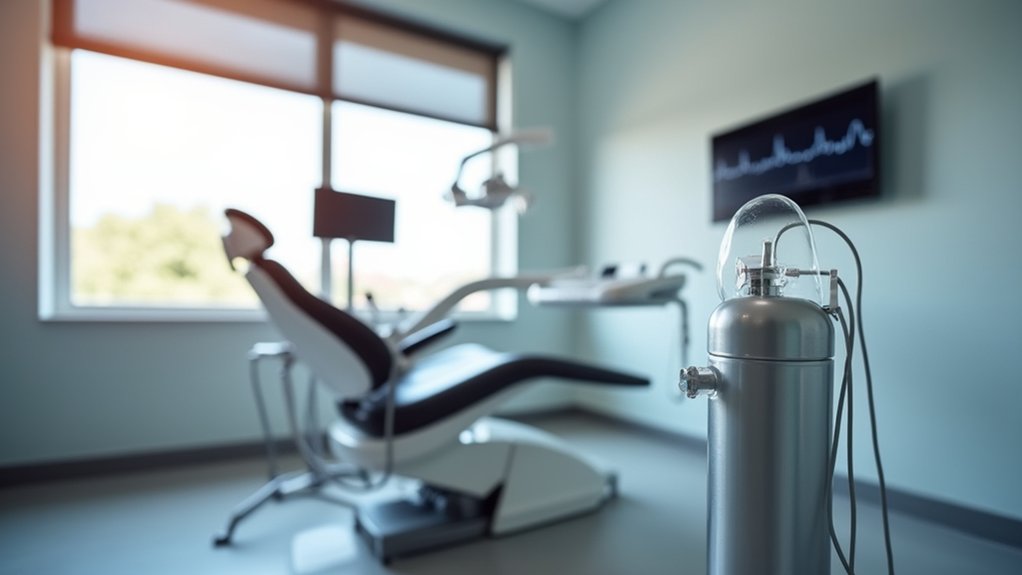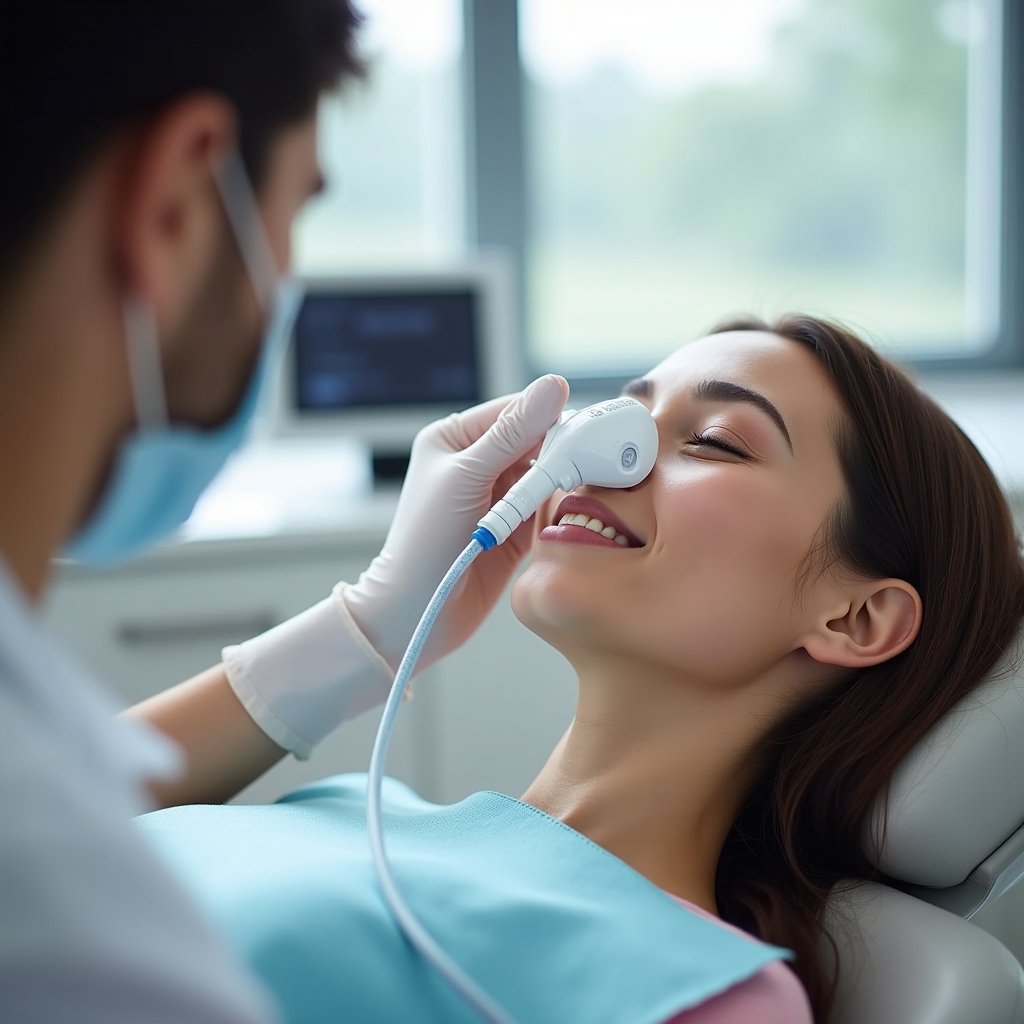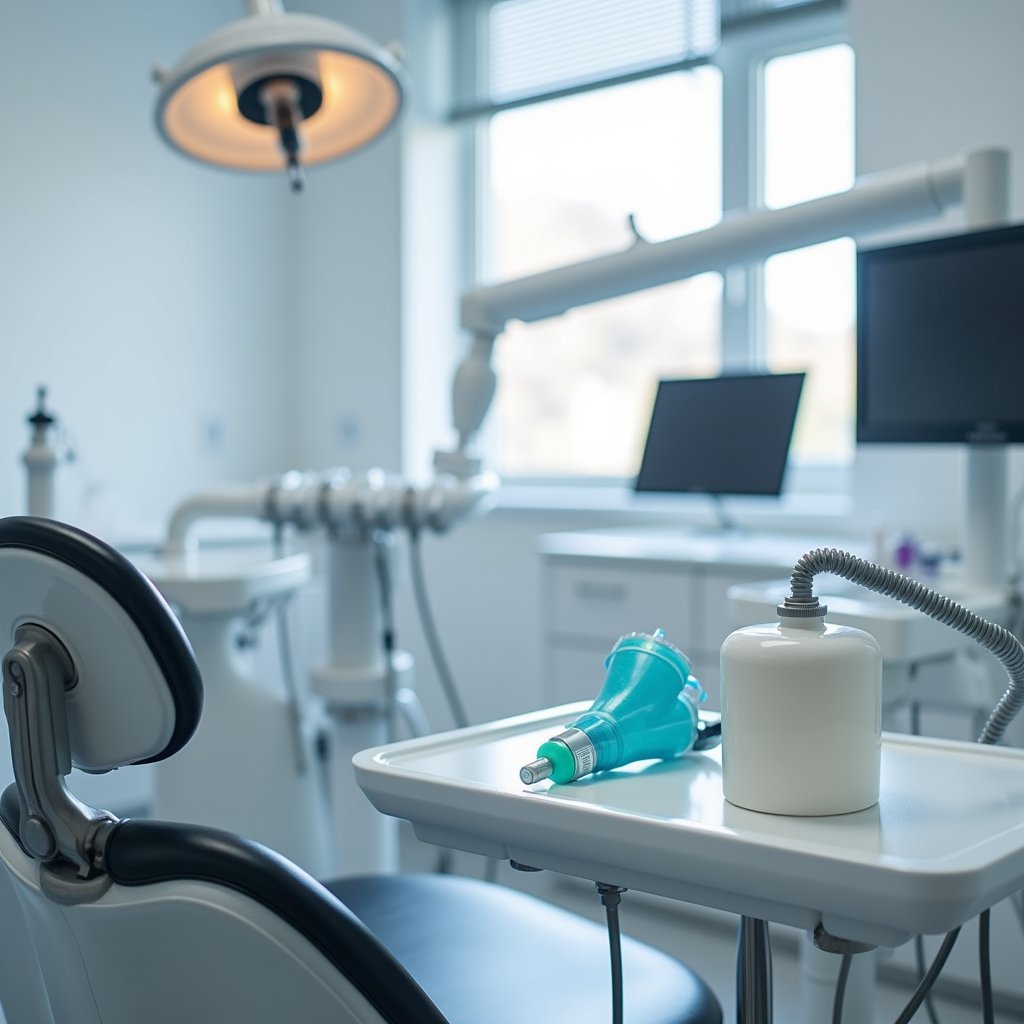During nitrous oxide treatment, you’ll breathe a controlled mixture of nitrous oxide and oxygen through a comfortable nasal mask while remaining fully conscious. Your dentist will gradually increase the gas concentration over several minutes until you feel relaxed, warm, and slightly tingly. Throughout the procedure, you’ll be monitored closely and can communicate normally. After treatment, you’ll receive pure oxygen for 5 minutes to clear the nitrous oxide. Understanding the complete process helps guarantee a safe, anxiety-free dental experience.
Before Your Nitrous Oxide Appointment

Before receiving nitrous oxide treatment, proper preparation helps certify a smooth and effective dental procedure. Your dietary considerations should include eating light meals and staying adequately hydrated before the appointment. Make sure to avoid food and drinks at least two hours before your scheduled visit. Don’t skip meals entirely, as this may affect your comfort during treatment. Nitrous oxide helps reduce dental anxiety through its rapid onset time when inhaled.
For personal hygiene preparations, you’ll need to remove nail polish and lipstick before arriving at the dental office. Wear loose, comfortable clothing that won’t restrict your breathing or movement. If you use contact lenses, consider wearing glasses instead to prevent eye irritation during treatment. Verify your nose is clear and unobstructed for proper mask placement. You should also inform your dentist about any medical conditions, medications, or allergies you have, as these factors may influence your treatment plan. Your dentist will maintain verbal contact with you throughout the procedure to ensure your comfort and safety.
The Setup and Safety Process
Three key components form the foundation of nitrous oxide setup and safety: equipment preparation, gas management, and monitoring systems. Your dental team will conduct thorough gas flow regulation checks and scavenging system inspection before treatment begins. A specialized system maintains a fixed 50/50 mixture of nitrous oxide and oxygen for safe delivery.
You’ll first be introduced to the nasal hood and monitoring equipment while the team verifies proper suction activation and airflow parameters. Your dental team may offer scented nasal hoods to enhance your comfort during treatment. The process starts with 100% oxygen delivery through green tanks, followed by careful titration of nitrous oxide from blue tanks. The staff will ensure the tubes fit comfortably in your nostrils before proceeding. Your critical signs will be continuously monitored as the gas mixture is adjusted.
Throughout treatment, the dental team maintains strict pressure monitoring of both gases while ensuring the scavenging system removes excess gases effectively. After treatment, you’ll receive pure oxygen for 5 minutes to safely clear the nitrous oxide from your system.
Your Experience During Treatment

During your nitrous oxide treatment, you’ll experience a carefully controlled administration process that begins with a 20% nitrous oxide and 80% oxygen mixture. Your dentist will monitor your comfort levels while gradually increasing the concentration in 10% increments every three minutes, ensuring ideal patient safety and effectiveness. The dentist will ensure gas flow delivery before placing the nasal hood.
You may notice initial sensory perceptions during treatment, such as tingling in your fingers or a feeling of warmth and lightness. These sensations indicate the medication is working properly. Your dentist will regularly observe your vital signs and comfort throughout the procedure. You’ll remain conscious but feel increasingly relaxed as the gas takes effect. Your dentist will ask simple questions to assess your response, though minimal conversation helps maintain proper nasal breathing for maximum benefit.
If needed, the concentration may be increased to 30% or 40% to achieve the desired level of comfort for your procedure.
Recovery and Aftercare Guidelines
Following your nitrous oxide treatment, proper recovery procedures help guarantee a safe return to normal activities. You’ll receive 100% oxygen for at least 5 minutes to clear the nitrous from your system. Your dental team will monitor your responsiveness and critical signs until you’re back to baseline awareness.
Most patients can drive and return to normal activities within 15-30 minutes after nitrous oxide sedation. However, if you’ve received oral sedation, you’ll need to wait 24 hours before driving. Having local anesthetic administered during your procedure will keep the treatment area numb for several hours after sedation wears off. Communication with your dentist is essential regarding any lingering effects like dizziness or nausea, which typically resolve within a day. For managing long-term effects, extended oxygen therapy may be provided if needed. Remember to follow any specific post-treatment instructions and contact your dentist if unusual symptoms persist.
Possible Side Effects and Precautions

While nitrous oxide sedation is generally safe, patients should be aware of potential side effects that occur in a small percentage of cases. Common reactions include temporary headaches, nausea, and dizziness, affecting roughly 5% of patients. You may experience brief disorientation during recovery as the gas clears from your system. Nitrous oxide has been a trusted dental sedation method since 1884. The medication induces a state of conscious sedation, allowing you to remain awake and responsive throughout the procedure.
If you undergo frequent procedures, you’ll need B12 supplements to prevent anemia, as nitrous oxide can inactivate certain enzymes. Medication interactions with other sedatives or local anesthetics require careful monitoring. Be sure to inform your dentist about any pre-existing conditions, as ASA Class 2 patients face higher sedation risks. Your dental team follows strict protocols regarding occupational exposure hazards, using proper ventilation and scavenging systems to maintain safe nitrous oxide concentrations during procedures.
Frequently Asked Questions
Can I Eat or Drink While Under Nitrous Oxide?
You shouldn’t attempt any food consumption or beverage intake while under nitrous oxide sedation. Your mouth will be occupied with dental work, and attempting to eat or drink could interfere with the treatment and pose safety risks.
Additionally, you’ll have dental instruments in your mouth, making it physically impossible to consume anything. Once your procedure is complete and the effects wear off, you can gradually resume eating and drinking.
How Much Does Nitrous Oxide Sedation Typically Cost?
Nitrous oxide sedation typically costs between $50-$200 per appointment, with the exact cost range varying by location and provider. You’ll find most dental offices charge around $100 for a standard session.
Many practices offer flexible payment options, including cash, credit cards, and payment plans. While dental insurance doesn’t typically cover nitrous oxide sedation, some providers may include it as part of certain procedures or offer package deals.
Will I Remember Everything That Happened During the Procedure?
You likely won’t remember everything from your procedure, as nitrous oxide specifically affects memory formation during sedation. Your awareness level will remain partially conscious, but you’ll experience significant gaps in your procedural memories.
While you’ll recall basic details like arriving at the office and post-treatment instructions, specific steps during treatment may be fuzzy or completely absent from your memory. These effects are temporary and resolve quickly after treatment.
Can Children Safely Receive Nitrous Oxide for Dental Procedures?
Yes, children can safely receive nitrous oxide for dental procedures when administered by trained professionals. You’ll find it’s a well-established sedation method that offers reduced anxiety levels while maintaining your child’s consciousness and improved breathing patterns.
The treatment is specifically designed for pediatric use, with precise dosage control and continuous monitoring. Your child will remain awake and responsive throughout the procedure, while experiencing a calming effect that makes dental work more manageable.
Does Insurance Usually Cover Nitrous Oxide Sedation for Dental Work?
Insurance coverage for dental nitrous oxide varies extensively by provider and policy. You’ll need to check your specific dental insurance benefits, as coverage requirements differ.
While some insurers cover nitrous oxide sedation when deemed medically necessary for anxiety or complex procedures, others may exclude it entirely. If it’s not covered, you’ll likely need to pay out-of-pocket.
Many practices will verify your benefits and discuss costs before treatment.






